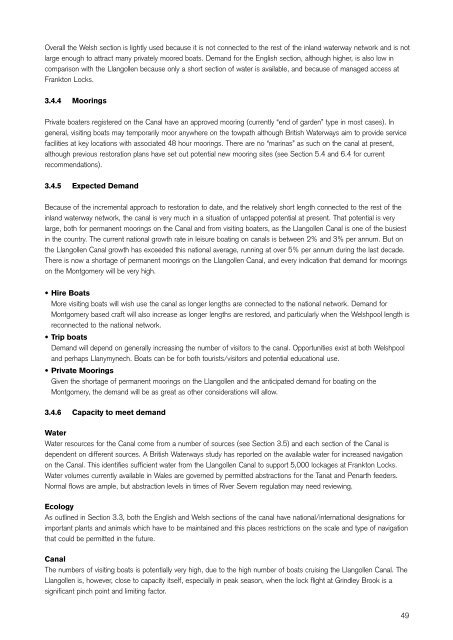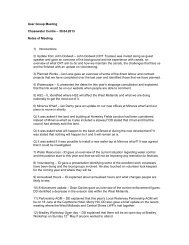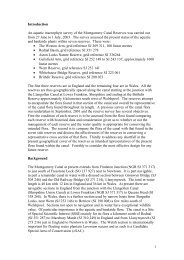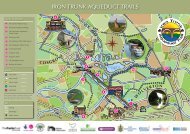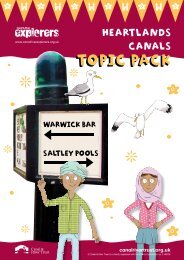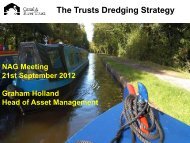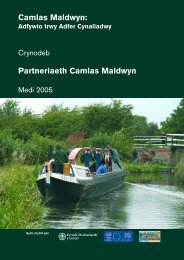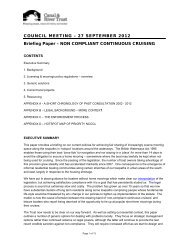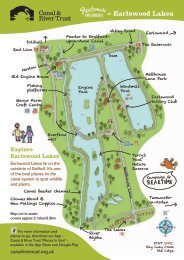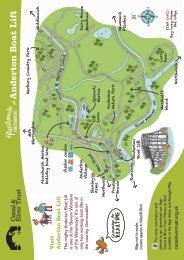Montgomery Canal Conservation Management Strategy (1.2MB PDF)
Montgomery Canal Conservation Management Strategy (1.2MB PDF)
Montgomery Canal Conservation Management Strategy (1.2MB PDF)
You also want an ePaper? Increase the reach of your titles
YUMPU automatically turns print PDFs into web optimized ePapers that Google loves.
Overall the Welsh section is lightly used because it is not connected to the rest of the inland waterway network and is not<br />
large enough to attract many privately moored boats. Demand for the English section, although higher, is also low in<br />
comparison with the Llangollen because only a short section of water is available, and because of managed access at<br />
Frankton Locks.<br />
3.4.4 Moorings<br />
Private boaters registered on the <strong>Canal</strong> have an approved mooring (currently “end of garden” type in most cases). In<br />
general, visiting boats may temporarily moor anywhere on the towpath although British Waterways aim to provide service<br />
facilities at key locations with associated 48 hour moorings. There are no “marinas” as such on the canal at present,<br />
although previous restoration plans have set out potential new mooring sites (see Section 5.4 and 6.4 for current<br />
recommendations).<br />
3.4.5 Expected Demand<br />
Because of the incremental approach to restoration to date, and the relatively short length connected to the rest of the<br />
inland waterway network, the canal is very much in a situation of untapped potential at present. That potential is very<br />
large, both for permanent moorings on the <strong>Canal</strong> and from visiting boaters, as the Llangollen <strong>Canal</strong> is one of the busiest<br />
in the country. The current national growth rate in leisure boating on canals is between 2% and 3% per annum. But on<br />
the Llangollen <strong>Canal</strong> growth has exceeded this national average, running at over 5% per annum during the last decade.<br />
There is now a shortage of permanent moorings on the Llangollen <strong>Canal</strong>, and every indication that demand for moorings<br />
on the <strong>Montgomery</strong> will be very high.<br />
• Hire Boats<br />
More visiting boats will wish use the canal as longer lengths are connected to the national network. Demand for<br />
<strong>Montgomery</strong> based craft will also increase as longer lengths are restored, and particularly when the Welshpool length is<br />
reconnected to the national network.<br />
• Trip boats<br />
Demand will depend on generally increasing the number of visitors to the canal. Opportunities exist at both Welshpool<br />
and perhaps Llanymynech. Boats can be for both tourists/visitors and potential educational use.<br />
• Private Moorings<br />
Given the shortage of permanent moorings on the Llangollen and the anticipated demand for boating on the<br />
<strong>Montgomery</strong>, the demand will be as great as other considerations will allow.<br />
3.4.6 Capacity to meet demand<br />
Water<br />
Water resources for the <strong>Canal</strong> come from a number of sources (see Section 3.5) and each section of the <strong>Canal</strong> is<br />
dependent on different sources. A British Waterways study has reported on the available water for increased navigation<br />
on the <strong>Canal</strong>. This identifies sufficient water from the Llangollen <strong>Canal</strong> to support 5,000 lockages at Frankton Locks.<br />
Water volumes currently available in Wales are governed by permitted abstractions for the Tanat and Penarth feeders.<br />
Normal flows are ample, but abstraction levels in times of River Severn regulation may need reviewing.<br />
Ecology<br />
As outlined in Section 3.3, both the English and Welsh sections of the canal have national/international designations for<br />
important plants and animals which have to be maintained and this places restrictions on the scale and type of navigation<br />
that could be permitted in the future.<br />
<strong>Canal</strong><br />
The numbers of visiting boats is potentially very high, due to the high number of boats cruising the Llangollen <strong>Canal</strong>. The<br />
Llangollen is, however, close to capacity itself, especially in peak season, when the lock flight at Grindley Brook is a<br />
significant pinch point and limiting factor.<br />
49


